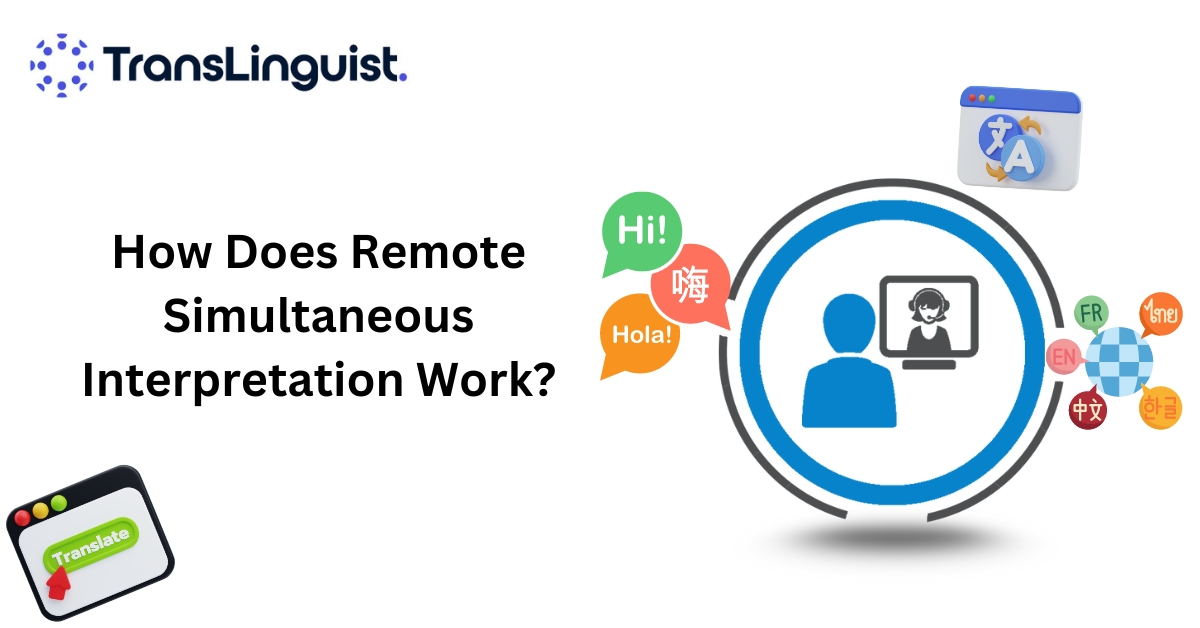In the present world, people from different regions want to talk to each other. However, sometimes they speak different languages. To help people understand each other, we use interpretation.
There are different types of interpretation: consecutive interpretation and simultaneous interpretation. Consecutive interpretation is when a person speaks, then it is translated by an interpreter in another language. While simultaneous interpretation is where the interpreter translates at the same time a person is speaking, In this blog, we will learn about remote simultaneous interpretation and how it has evolved the world of translation and interpretation.
Challenges in Remote Simultaneous Interpretation (RSI)
There can be a few challenges to simultaneous interpretation. The most common ones are:
Technical Issues:
This problem can include technicalities faced by either the speaker, audience, or interpreter. A poor internet connection can lead to delays or interruptions that affect the quality of interpretation.
Background Noise:
This is either the speaker’s or interpreter’s environmental noise. This can pose challenges for clear communication. Therefore, it is best to be in a quiet environment to ensure high-quality interpretation.
Concentration of the Interpreter:
Interpreters require intense focus to provide accurate simultaneous interpretation. Therefore, it is necessary to provide them breaks and optimal working conditions to sustain performance.
Multiple Integration Between Software’s:
Some companies face problems because of different software’s that are integrated in between meetings, which then hinders the ability to effectively communicate as this leads to signal distortion, which leads to noise in between meetings or conferences.
Why Do We Need Remote Simultaneous Interpretation (RSI)?
There are multiple organizations and events happening globally. Wherever people are gathering from all around the world to discuss or interact, there are language barriers that challenge effective communication. Unlike consecutive interpretation, where we have to wait for the interpreter to interpret, remote simultaneous interpretation helps everyone understand what is being said without having to wait. For meetings, it enhances communication and helps people understand each other better while speaking in the language they are most comfortable with.
How Does it Work?
Remote simultaneous interpretation is the process of translating speech from one language to another in real time. To start, we need some basic equipment that we use in our daily lives, such as a computer, laptop or mobile phone, an internet connection, a microphone, and headphones. All of these are easily accessible.
Process:
Online cloud-based platform is consider the best process of simultaneous interpretation. This platform is used for meetings or some equipment for conferences or events in a hybrid setting. For simultaneous interpretation, the speaker is speaking on one channel, while the interpreter is listening to the speaker and translating it into another language in real time on another channel. Listeners can listen in on the desired language channel of their own choice.
For consecutive interpretation, there is only one channel. The speaker talks, and then the interpreter translates while the audience is listening.
For remote simultaneous interpretation, there are multiple software programs used to connect speakers and interpreters in different parts of the world. The principles of consecutive and simultaneous interpretation both apply in RSI. Most common are Zoom and Teams.
Benefits of Remote Simultaneous Interpretation
RSI opens up a whole new world for interpretation needs because of the following reasons:
Flexibility:
It offers flexibility and accessibility for interpreters to work remotely from anywhere in the world. This allows interpreters to travel less and avoid any unnecessary complications. Simultaneous interpretation also opens up opportunities for interpreters all over the world, giving them more opportunities.
Cost-Cutting:
For interpretation, there is a need for equipment such as audio/visual boards and interpretation booths, as well as the need for interpreters to travel and accommodation charges. Remote simultaneous interpretation allows companies and individuals to cut costs for consecutive and simultaneous interpretation by eliminating the need for travel, accommodations, and booths.
How TransLinguist Revolutionizes Remote Simultaneous Interpretation (RSI) ?
TransLinguist revolutionizes video remote interpretation (VRI) and remote simultaneous interpretation (RSI) through TransLinguist Interactive. TransLinguist Interactive is a cloud-based platform specifically made for the sole purpose of meeting linguistic needs. It contains multiple features and allows users to hear interpretations in their own choice of language from the comfort of any electronic device.
TransLinguist Interactive gives you features to schedule calls in your desired language and hold meetings on the platform, but it also allows you to integrate with Teams and Zoom. After scheduling the meeting, you have two options, which are speech AI and live interpreters. Upon selection of speech AI, you eliminate the need for interpreters. Therefore, cutting costs and getting accurate translations is important, as speech AI gives about 85–90% accurate translations. While selecting live interpreters, we match you with the best interpreters on our marketplace through AI for your specific requirements.
Whether you’re looking to enhance your video remote interpretation (VRI) and remote simultaneous interpretation (RSI) solutions, Contact us today for more information.




